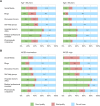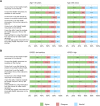Unleashing the potential of eHealth in outpatient cancer care for patients undergoing immunotherapy-a quantitative study considering patients' needs and current healthcare challenges
- PMID: 39498102
- PMCID: PMC11532137
- DOI: 10.3389/fdgth.2024.1414442
Unleashing the potential of eHealth in outpatient cancer care for patients undergoing immunotherapy-a quantitative study considering patients' needs and current healthcare challenges
Abstract
Background: The use of online information and communication is globally increasing in the healthcare sector. In addition to known benefits in other medical fields, possible specific potentials of eHealth lie in the monitoring of oncological patients undergoing outpatient therapy. Specifically, the treatment with immune checkpoint inhibitors (ICI) requires intensive monitoring due to various possible negative side effects. The present study explores cancer patients' perspectives on eHealth and demonstrates how eHealth applications, from the patients' point of view, can contribute to further improving outpatient immunotherapy.
Methods and findings: Our multicenter study was executed at the university hospitals in Bonn and Aachen. A structured questionnaire was distributed to patients receiving outpatient immunotherapy. Contents addressed were (1) the patients' attitude towards eHealth applications, (2) the use of modern information and communications technologies (ICT) in (2a) everyday life and (2b) health-related information search including eHealth literacy, (3) the use of internet-enabled devices as well as (4) socio-demographic data. 164 patients were included in the study, of whom 39.0% were female and 61.0% male and the average age was 62.8 years. Overall, there was a high distribution of internet-enabled devices for everyday use and a great interest in integrating eHealth applications into outpatient immunotherapy. The assessment of eHealth potentials significantly depended on age. The younger participants demonstrated a broader use of modern ICT and a higher affinity for its use in outpatient immunotherapy. In some aspects, level of education and gender were also relevant factors influencing the patients' view on eHealth.
Conclusion: This study demonstrates the potential for further integration of eHealth applications into outpatient immunotherapy from the patients' perspective. It indicates a dependency on age and educational level for the further integration of eHealth into patient care in oncology. Due to particular patient needs regarding age, level of education, gender and other subgroups, specific education and training as well as target-group specific digital health interventions are necessary to fully utilize the potentials of eHealth for outpatient immunotherapy. Future studies are required to specifically address target-group specific usability of eHealth applications and eHealth literacy, as well as to address information security and data protection.
Keywords: cellular therapy; digital health; eHealth; immune checkpoint inhibitors; immunotherapy; outpatient care; telemedicine.
© 2024 Holderried, Stasik, Schmitz, Schmitz, Meyer, Stauß, Kirschner, Skowasch, Landsberg, Schmid, Brossart and Holderried.
Conflict of interest statement
The authors declare that the research was conducted in the absence of any commercial or financial relationships that could be construed as a potential conflict of interest. The author(s) declared that they were an editorial board member of Frontiers, at the time of submission. This had no impact on the peer review process and the final decision.
Figures




Similar articles
-
The potential of eHealth for cancer patients-does COVID-19 pandemic change the attitude towards use of telemedicine services?PLoS One. 2023 Feb 10;18(2):e0280723. doi: 10.1371/journal.pone.0280723. eCollection 2023. PLoS One. 2023. PMID: 36763640 Free PMC article.
-
Attitude and potential benefits of modern information and communication technology use and telemedicine in cross-sectoral solid organ transplant care.Sci Rep. 2021 Apr 27;11(1):9037. doi: 10.1038/s41598-021-88447-6. Sci Rep. 2021. PMID: 33907269 Free PMC article.
-
Usability and Usefulness of a Symptom Management Coaching System for Patients With Cancer Treated With Immune Checkpoint Inhibitors: Comparative Mixed Methods Study.JMIR Form Res. 2025 Jan 23;9:e57659. doi: 10.2196/57659. JMIR Form Res. 2025. PMID: 39847771 Free PMC article.
-
Qualitative Research Studies Addressing Patient-Practitioner Communication about Online Health Information.Int J Environ Res Public Health. 2022 Oct 27;19(21):14004. doi: 10.3390/ijerph192114004. Int J Environ Res Public Health. 2022. PMID: 36360881 Free PMC article. Review.
-
A systematic review and knowledge mapping on ICT-based remote and automatic COVID-19 patient monitoring and care.BMC Health Serv Res. 2023 Sep 30;23(1):1047. doi: 10.1186/s12913-023-10047-z. BMC Health Serv Res. 2023. PMID: 37777722 Free PMC article.
References
-
- World Health Organization. eHealth. Geneva: World Health Organization; (2023). Available online at: http://www.emro.who.int/health-topics/ehealth/ (accessed May 28, 2024).
-
- de las Cuevas C, Gutiérrez-Rojas L, Alvarez-Mon MA, Andreu-Bernabeu Á, Capitán L, Gómez JC, et al. Evaluating the effect of a telepsychiatry educational program on the awareness, knowledge, attitude, and skills of telepsychiatry among spanish psychiatrists during COVID-19 pandemic. Telemedicine and e-Health. (2023) 29:102–8. 10.1089/tmj.2022.0051 - DOI - PubMed
LinkOut - more resources
Full Text Sources

